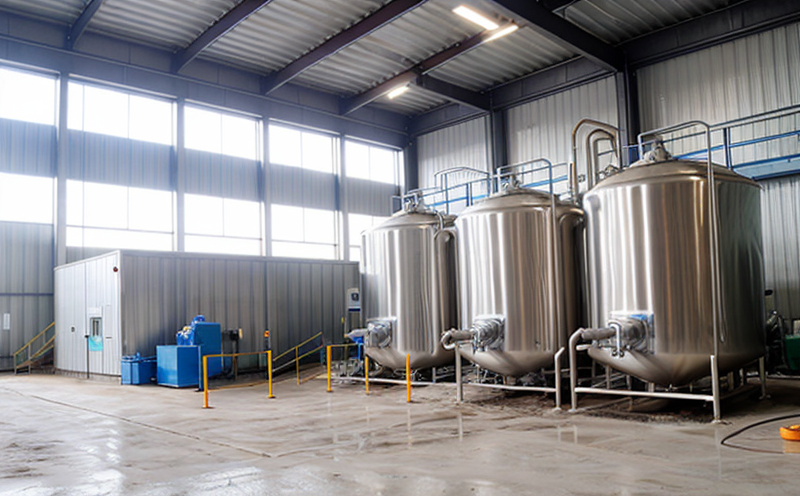EPA 8270 Semi Volatile Organic Compounds SVOC Test in Industrial Water
The EPA Method 8270 is a widely recognized analytical procedure designed to identify and quantify semi-volatile organic compounds (SVOCs) in various matrices, including industrial process water. This method has been validated for its accuracy and precision across numerous applications, making it an essential tool for ensuring environmental compliance and safeguarding public health.
SVOCs are a class of chemicals that have boiling points above 250°C and can persist in the environment longer than volatile organic compounds (VOCs). These compounds can originate from industrial processes, waste management activities, or other sources. In industrial settings, SVOCs may be present in water used for various purposes, including cooling, cleaning, and process control. Detecting and monitoring these compounds is crucial to maintaining regulatory compliance and protecting workers and the environment.
The EPA 8270 method employs a multi-step extraction process followed by gas chromatography-mass spectrometry (GC-MS) analysis. This technique allows for both qualitative and quantitative determination of SVOCs, providing comprehensive data on the chemical composition of industrial water samples. The method is applicable to a wide range of SVOCs, including pesticides, polychlorinated biphenyls (PCBs), and other hazardous substances.
Sample preparation is critical in this testing process. Industrial water samples are typically collected from various points within the facility, ensuring that representative samples are analyzed for SVOC content. The samples undergo extraction using a solvent-based method before being injected into the GC-MS instrument. This step ensures that all target compounds are efficiently extracted and prepared for analysis.
The analytical process involves several key steps: sample conditioning, extraction, cleanup, derivatization (if necessary), injection, and finally, detection and quantification through GC-MS. The use of high-performance liquid chromatography (HPLC) can also be integrated into the process to enhance separation capabilities for complex mixtures.
The precision and accuracy of results depend heavily on proper sample collection, storage, and handling practices. Compliance with specific matrix-specific requirements is crucial for obtaining reliable data. Regulatory bodies such as the EPA provide detailed guidelines on how to handle industrial water samples according to EPA 8270.
Understanding the significance of SVOCs in industrial applications requires an awareness of their potential impacts on human health and the environment. By adhering to strict testing protocols like EPA Method 8270, industries can ensure that they are meeting regulatory standards while also contributing to environmental sustainability efforts.
Industry Applications
| Industries | Applications |
|---|---|
| Pharmaceuticals | Detecting impurities in water used for production processes. |
| Chemical Manufacturing | Monitoring reaction byproducts and ensuring product purity. |
| Petrochemicals | Identifying potential contamination sources from refinery operations. |
| Semiconductor Fabrication | Ensuring water quality meets stringent standards for cleanroom environments. |
| Mining Operations | Assessing the impact of mining activities on local water sources. |
| Agriculture | Evaluating irrigation water for trace contaminants that may affect crop quality. |
| Food Processing | Monitoring process water to ensure it does not contain harmful SVOCs. |
| Biofuel Production | Detecting solvents and other chemicals used in the production of biofuels. |
The diverse range of industries highlighted above underscores the versatility of EPA 8270 Method 8270 SVOC testing. By providing detailed insights into the presence, concentration, and identity of SVOCs within industrial water systems, this method supports informed decision-making processes across various sectors.
Quality and Reliability Assurance
EPA 8270 Method 8270 is a robust analytical technique that ensures consistent and reliable results. The method's reproducibility is enhanced by standardized procedures for sample handling, extraction, and analysis. Regular calibration of instrumentation and quality control checks further bolster the reliability of test outcomes.
Quality assurance (QA) measures include the use of certified reference materials (CRMs) to validate analytical methods. CRMs provide a known concentration of SVOCs, allowing laboratories to assess their accuracy and precision during testing. Laboratories must also participate in proficiency testing programs organized by regulatory bodies or third-party organizations.
The reliability of EPA 8270 results is bolstered by adherence to strict quality control protocols throughout the entire analytical process. This includes rigorous training for analysts, regular calibration of instruments, and continuous monitoring of method performance. By maintaining these stringent standards, laboratories can ensure that their findings are credible and actionable.
Moreover, accredited laboratories like ours employ advanced equipment and experienced personnel trained in handling complex samples containing SVOCs. Our commitment to excellence extends beyond just meeting regulatory requirements; we strive to exceed expectations by delivering accurate, reproducible results consistently.
International Acceptance and Recognition
EPA 8270 Method 8270 has gained widespread acceptance globally due to its rigorous validation process and consistent performance across different environments. This method is recognized not only by the United States Environmental Protection Agency but also by other international regulatory bodies such as the European Union (EU), Organization for Economic Co-operation and Development (OECD), and International Standards Organization (ISO).
The EU's Registration, Evaluation, Authorization and Restriction of Chemicals (REACH) framework incorporates EPA 8270 as a reference method for assessing SVOC content in industrial water. Similarly, OECD guidelines recommend the use of this method for environmental risk assessments involving SVOCs.
ISO standards also recognize EPA 8270, reflecting its importance in ensuring consistent and reliable testing across industries worldwide. By adopting internationally accepted methods like EPA 8270, organizations can ensure that their compliance efforts are aligned with global best practices.
The global recognition of EPA Method 8270 underscores the significance of this analytical technique in maintaining environmental integrity and promoting sustainable industrial practices. As international standards continue to evolve, laboratories must stay abreast of these developments to maintain their credibility and effectiveness.





